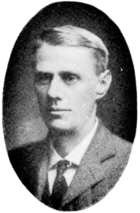John Nanson
|
The Honourable John Nanson |
|
|---|---|
 |
|
| Attorney-General of Western Australia | |
|
In office 30 June 1909 – 7 October 1911 |
|
| Premier |
Newton Moore Frank Wilson |
| Preceded by | Hector Rason |
| Succeeded by | Thomas Walker |
| Member of the Legislative Assembly of Western Australia |
|
|
In office 24 April 1901 – 28 June 1904 |
|
| Preceded by | Samuel Mitchell |
| Succeeded by | John Holman |
| Constituency | Murchison |
|
In office 28 June 1904 – 27 October 1905 |
|
| Preceded by | Patrick Stone |
| Succeeded by | Patrick Stone |
| Constituency | Greenough |
|
In office 11 September 1908 – 21 October 1914 |
|
| Preceded by | Patrick Stone |
| Succeeded by | John Cunningham |
| Constituency | Greenough |
| Personal details | |
| Born |
22 September 1863 Carlisle, Cumberland, England |
| Died | 29 February 1916 (aged 52) Wimborne, Dorset, England |
John Leighton Nanson (22 September 1863 – 29 February 1916) was a journalist and politician in Western Australia. A former writer and sub-editor with The West Australian, he served in the Legislative Assembly of Western Australia from 1901 to 1905 and again from 1908 to 1914. Nanson was a minister in the governments of Alf Morgans, Walter James, Newton Moore, and Frank Wilson, including as attorney-general from 1909 to 1911.
Nanson was born in Carlisle, Cumberland, England. He attended Carlisle Grammar School and King William's College (on the Isle of Man). After leaving school, Nanson emigrated to Australia, initially living in Broken Hill, New South Wales, and then going to South Australia. He arrived in Western Australia in the mid-1880s, worked as a journalist. In 1899, he was made an associate editor of The West Australian, having previously served as its Fremantle correspondent.
Nanson was elected to parliament at the 1901 state election, winning the seat of Murchison from the sitting member, Samuel Mitchell. In November 1901, after only seven months as an MP, he was made Minister for Lands in the newly formed Morgans ministry, which lasted for just 32 days. Nanson was elevated to the ministry for a second time in January 1904, as a minister without portfolio in the James ministry. He replaced Hector Rason as Minister for Works a few months later, but the government fell in August 1904 (after a vote of no confidence).
...
Wikipedia
